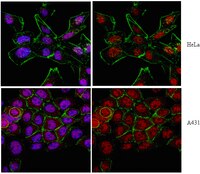06-1049 Sigma-AldrichAnti-Axin-1 Antibody
Anti-Axin-1 Antibody is an antibody against Axin-1 for use in WB, IC, IH.
More>> Anti-Axin-1 Antibody is an antibody against Axin-1 for use in WB, IC, IH. Less<<Recommended Products
Overview
| Replacement Information |
|---|
Key Specifications Table
| Species Reactivity | Key Applications | Host | Format | Antibody Type |
|---|---|---|---|---|
| H, M | WB, ICC, IHC | Rb | Affinity Purified | Polyclonal Antibody |
| References |
|---|
| Product Information | |
|---|---|
| Format | Affinity Purified |
| HS Code | 3002 15 90 |
| Control |
|
| Presentation | Purified rabbit polyclonal in buffer containing 0.1 M Tris-Glycine (pH 7.4), 150 mM NaCl with 0.05% sodium azide. |
| Quality Level | MQ100 |
| Physicochemical Information |
|---|
| Dimensions |
|---|
| Materials Information |
|---|
| Toxicological Information |
|---|
| Safety Information according to GHS |
|---|
| Safety Information |
|---|
| Storage and Shipping Information | |
|---|---|
| Storage Conditions | Stable for 1 year at 2-8°C from date of receipt. |
| Packaging Information | |
|---|---|
| Material Size | 100 µg |
| Transport Information |
|---|
| Supplemental Information |
|---|
| Specifications |
|---|
| Global Trade Item Number | |
|---|---|
| Catalog Number | GTIN |
| 06-1049 | 04053252292552 |
Documentation
Anti-Axin-1 Antibody SDS
| Title |
|---|
Anti-Axin-1 Antibody Certificates of Analysis
| Title | Lot Number |
|---|---|
| Anti-Axin-1 - 1953006 | 1953006 |
| Anti-Axin-1 - 2293539 | 2293539 |
| Anti-Axin-1 - 2499166 | 2499166 |
| Anti-Axin-1 - 3170228 | 3170228 |
| Anti-Axin-1 - NRG1872321 | NRG1872321 |
| Anti-Axin-1 -2567149 | 2567149 |
| Anti-Axin-1 -2849043 | 2849043 |
| Anti-Axin-1 Polyclonal Antibody | 3092001 |
| Anti-Axin-1 Polyclonal Antibody | 2919610 |
| Anti-Axin-1 Polyclonal Antibody | 2942459 |
















